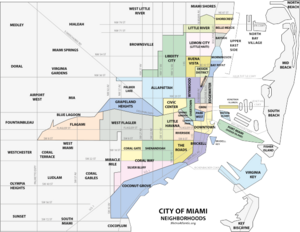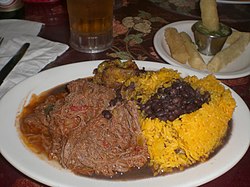Little Havana
Little Havana
La Pequeña Habana | |
|---|---|
 Little Havana's famous Domino Park on Calle Ocho | |
 Little Havana neighborhood within the city of Miami | |
| Country | United States |
| State | Florida |
| County | Miami-Dade County |
| City | Miami |
| Government | |
| • City of Miami Commissioner | Frank Carollo |
| • Miami-Dade Commissioners | Carlos A. Giménez and Bruno Barreiro |
| • House of Representatives | Carlos Lopez-Cantera (R) and Luis García, Jr. (R) |
| • State Senate | Miguel Díaz de la Portilla (R) |
| • U.S. House | Ileana Ros-Lehtinen (R) |
| Population (2010) | |
• Total | 76,163 |
| • Density | 21,815/sq mi (8,423/km2) |
| Time zone | UTC-05 (EST) |
| ZIP Code | 33125, 33126, 33128, 33130, 33135 |
| Area code(s) | 305, 786 |

Little Havana (Template:Lang-es) is a neighborhood of Miami, Florida, United States. Home to many Cuban immigrant residents, as well as many residents from Central and South America, Little Havana is named after Havana, the capital and largest city in Cuba.
Little Havana is noted as a center of social, cultural, and political activity in Miami. Its festivals, including the Calle Ocho Festival, Viernes Culturales/Cultural Fridays, the Three Kings Parade and others, have been televised to millions of people every year on different continents. It is also known for its landmarks, including Calle Ocho (SW 8th Street/Tamiami Trail), and its Walk of Fame (for famous artists and Latin personalities, including Celia Cruz, Willy Chirino, and Gloria Estefan), the Cuban Memorial Boulevard, Plaza de la Cubanidad, Domino Park, the Tower Theater, Jose Marti Park, the Firestone/Walgreens Building, St. John Bosco Catholic Church, Municipio de Santiago de Cuba and others.
Little Havana is the best known neighborhood for Cuban exiles in the world. It is characterized by its street life, with restaurants, music and other cultural activities, mom and pop enterprises, political passion, and great warmth amongst its residents.[1]
History
This section needs expansion. You can help by adding to it. (July 2011) |
Originally a lower-middle-class Southern and a thriving Jewish neighborhood in the 1930s.[2][3] The name "Little Havana" emerged in the 1960s as the concentration of Cubans in the area grew sharply. Little Havana is the name affixed to a sprawling neighborhood lying immediately west of Downtown Miami. It stretches west from the Miami River for several miles. This sobriquet was applied to the Shenandoah and Riverside neighborhoods in the 1960s, following the beginnings of a vast influx of Cuban refugees there. Little Havana is famous as the cultural and political capital of Cuban Americans, and the neighborhood is a center of the Cuban exile community.[4]
As of 2011, Little Havana has the highest concentration of Hispanics (98%) in Miami. Within the Hispanic population, the Cuban population has experienced a substantial decrease from 84% in 1979 to 58% in 1989; however, a group of Hispanics from other countries, especially those from Nicaragua, Honduras, and other Central American countries has substantially increased since the late-1990s.[5]
Borders
Locals are in disagreement about the exact boundaries, but most consider the neighborhood to be:
- Western Border: NW 37th Avenue and SW 37th Avenue
- Eastern Border: I-95 near Calle Ocho (SW 8th Street) between SW 11th and SW 4th Streets, and NW South River Drive further north;
- Northern Border: Miami River (east side) from the east end to NW 20th Street, then NW 20th Street to the west end
- Southern Border: SW 11th Street from the east end to SW 12th Avenue, then SW 8th Street to SW 27th Avenue, then SW 16th Street to the west end

Demographics
As of 2000,[6] Little Havana had a population of 49,206 residents, with 19,341 households, and 11,266 families residing in the neighborhood. The median household income was $15,213.16. The ethnic makeup of the neighborhood was 85.08% Hispanic or Latino of any race (mainly Cubans, but also many Nicaraguans and Hondurans, as well as other Latinos), 3.79% Black or African American (not including Afro-Cubans, Afro-Nicaraguans, Afro-Hondurans, and other Afro-Latinos), 10.14% Non-Hispanic White, and 0.96% of other races.
South River Drive Historic District
South River Drive Historic District | |
 | |
| Location | Little Havana, Miami, Florida |
|---|---|
| Area | 25 acres (100,000 m2) |
| NRHP reference No. | 87000671 |
| Added to NRHP | August 10, 1987 |
The South River Drive Historic District is a U.S. historic district (designated as such on August 10, 1987) located in Miami's Little Havana neighborhood on the eastern end of the neighborhood along the Miami River just west of Downtown Miami. The district includes 428, 438 Southwest 1st Street, 437 Southwest 2nd Street, 104, 109, 118 Southwest South River Drive. It contains 9 historic buildings.[7]
Viernes Culturales

Viernes Culturales (English: Cultural Fridays) is an artistic, cultural, and social arts and culture fair that takes place on the last Friday of each month in the historic Little Havana neighborhood of Miami in the heart of Calle Ocho (8th St. SW between 14th and 17th Avenues). A powerful venue for talented visual artists and entertainers, the monthly festival offers an opportunity for visitors and tourists to experience an evening of culture with the diverse flavors of our Latino community.
The event consists of outdoor musical performances on a stage and along the sidewalks of Calle Ocho, art exhibits along the sidewalk and in plazas and open spaces, visits to art galleries and cultural centers, cuisine tasting at participating restaurants, and films, art exhibits, and educational programs at the historic Tower Theatre. Free walking tours, led by famed Miami historian Dr. Paul George leave from the Tower Theater at 7pm each festival.[8]
Churches
- St. John Bosco Catholic Church
- St. Raymond Catholic Church
- St. Jude Catholic Church
- St. Barbara Old Catholic Church (schismatic)
Parks
- Máximo Gómez Park (better known as Domino Park), Calle Ocho
- Plaza de la Cubanidad
- Cuban Memorial Boulevard Park (SW 13th Avenue)
- Sewell Park
- Fern Isle Park
- Henderson Park
- Riverside Park
- Grapeland Heights Waterpark
- Jose Marti Park
Education



Miami-Dade County Public Schools runs area public schools. Schools within Little Havana include:
Public schools
Elementary schools
- Citrus Grove Elementary School
- Riverside Elementary School
- Auburndale Elementary School
- Kinloch Park Elementary School
- Shenandoah Elementary School
- Kensington Park Elementary School
- Ada Merritt K-8 School
- Hemdry T. Llanes Elementary A. School
Middle schools
- Citrus Grove Middle School
- Kinloch Park Middle School
- Shenandoah Middle School
High schools
- Miami Senior High School, founded in 1903 (the oldest high school in Miami)
- Young Women's Preparatory Academy (all-girls)
- Mater East Academy Charter High School and elementary schools
Colleges
- Miami Dade College- InterAmerican Campus
Libraries
Miami-Dade Public Library operates all area public libraries:
- Hispanic Library
- West Flagler Library
- Shenandoah Library
Cultural institutions
- L'Alliance Française de Miami, French language and cultural society
- La Società Dante Alighieri, Italian language and cultural society
Museums and memorials
- Bay of Pigs Museum and Library
- Cuban Memorial Boulevard Park (SW 13th Avenue)
Theaters and performance arts
- Tower Theatre, 1508 SW 8th St
- Manuel Artime Theatre, 900 SW 1st St
- Miami-Dade County Auditorium, 2901 W Flagler St
- Teatro 8, 2101 SW 8th St
- ArtSpoken Performing Arts Center, 529 SW 12th Ave
- Havanafama, 752 SW 10th Ave
- Teatro Avante, 138 East 27th Street
Calle Ocho Festival

Little Havana hosts its annual Calle Ocho street festival (part of the overall Carnaval Miami celebration), one of the largest in the world, with over one million visitors attending Calle Ocho alone. It is a free street festival with a Caribbean carnival feel sponsored by the Kiwanis Club of Little Havana.
Calle Ocho is where different ethnic communities wear colors or flags representing pride in their heritage. Flags from Colombia to Nicaragua to Puerto Rico to Costa Rica and even Ireland flood the streets. Foods from different countries are usually sold, and popular music like reggaeton, salsa, bachata and merengue can be heard through the festival.
In 1977 tensions among Miami’s different ethnic groups were running high. Eight Cuban-Americans, mostly from the Kiwanis of Little Havana, were trying to come up with ideas to address the situation. They considered a bicycle race on SW Eighth Street (Calle Ocho). It was turned down because the organizers feared that it would pit one ethnic group against another. Willy Bermello came up with the idea of doing something similar to the block parties and street festivals of Philadelphia. Calle Ocho was born.[9]
The festival takes place between 27th Ave and 4th Ave along Southwest 8th Street. Over 30 stages and hundreds of street vendors participate in the live music street festival now in its 3rd decade. Calle Ocho earned an entry in the Guinness Book of World Records when 119,986 people formed the world's longest conga line on March 13, 1988.
In 2010, the Florida legislature identified the Calle Ocho-Open House 8 festival as the official state festival.[10]
Places of interest

- Calle Ocho (SW 8th Street)
- Cuban Memorial Boulevard (SW 13th Avenue)
- Little Havana Visitors Center (1600 SW 8 Street)
- Centro Cultural Español de Cooperación Iberoamericana,[1]
- Versailles Restaurant
- Padilla Cigar Factory [2]
- Marlins Park (former site of the Orange Bowl)
- Calle Ocho Walk of Fame (SW 8th Street between SW 12th Avenue and SW 17th Avenue)
Gallery
-
Cuban Memorial Plaza on SW 13th Avenue & Calle Ocho
-
Bay of Pigs Invasion Monument
-
Bust of José Martí
-
Memorial plaque of Cuba
-
Wall mural on SW 14th Avenue & Calle Ocho
-
Domino Park
-
Tower Theater at 1508 Calle Ocho
-
Futurama Furniture Sign at 1513 Calle Ocho
-
Marlins Park under construction
See also
- Havana on the Hudson
- Cuba–United States relations
- Cuban-American lobby
- Mariel boatlift
- Opposition to Fidel Castro
References
- ^ http://metroatlantic.org/2012/10/27/walk-calle-ocho-little-havana-miami/
- ^ http://flashbackmiami.com/2014/07/23/little-havana
- ^ http://usatoday30.usatoday.com/news/nation/2007-08-31-513912598_x.htm
- ^ http://metroatlantic.org/2012/10/27/walk-calle-ocho-little-havana-miami/
- ^ http://www.miamigov.com/nets/pages/LittleHavana/Your%20community.asp
- ^ "Demographics of Little Havana Miami, FL". miamigov.com. Retrieved 2008-06-11.
- ^ http://www.nationalregisterofhistoricplaces.com/FL/Dade/districts.html
- ^ http://www.viernesculturales.org
- ^ Bernadette R Giacomazzo, "Calle Ocho Festival: The History of Little Havana's Most Famous Music Celebration" Latin Post, February 28, 2014
- ^ "2008 Florida Statutes, Title IV, Chapter 15 section 15.0395". State of Florida. Retrieved 2011-05-19.










